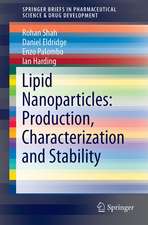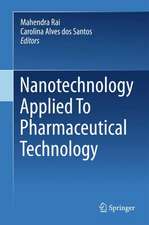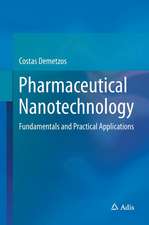Polymer Nanoparticles for Nanomedicines: A Guide for their Design, Preparation and Development
Editat de Christine Vauthier, Gilles Ponchelen Limba Engleză Hardback – 18 ian 2017
| Toate formatele și edițiile | Preț | Express |
|---|---|---|
| Paperback (1) | 1400.96 lei 6-8 săpt. | |
| Springer International Publishing – 12 iul 2018 | 1400.96 lei 6-8 săpt. | |
| Hardback (1) | 1756.27 lei 6-8 săpt. | |
| Springer International Publishing – 18 ian 2017 | 1756.27 lei 6-8 săpt. |
Preț: 1756.27 lei
Preț vechi: 2141.80 lei
-18% Nou
Puncte Express: 2634
Preț estimativ în valută:
336.10€ • 364.96$ • 282.33£
336.10€ • 364.96$ • 282.33£
Carte tipărită la comandă
Livrare economică 22 aprilie-06 mai
Preluare comenzi: 021 569.72.76
Specificații
ISBN-13: 9783319414195
ISBN-10: 3319414194
Pagini: 535
Ilustrații: XXIX, 641 p. 115 illus., 80 illus. in color.
Dimensiuni: 155 x 235 x 37 mm
Greutate: 11.23 kg
Ediția:1st ed. 2016
Editura: Springer International Publishing
Colecția Springer
Locul publicării:Cham, Switzerland
ISBN-10: 3319414194
Pagini: 535
Ilustrații: XXIX, 641 p. 115 illus., 80 illus. in color.
Dimensiuni: 155 x 235 x 37 mm
Greutate: 11.23 kg
Ediția:1st ed. 2016
Editura: Springer International Publishing
Colecția Springer
Locul publicării:Cham, Switzerland
Cuprins
Preface.- Introduction Part I: Polymer nanoparticles for in vivo applications: Progress on preparation methods and future challenges.- Nanoprecipitation process: From particlepreparation to in vivo applications.- Targeted Theragnostic Nanoparticles via Flash Nanoprecipitation: Principles of Materials Selection.- Preparation of polymer nanoparticles by the emulsification-solvent evaporation method: from Vanderhoff´s pioneer approach to recent adaptations.- Methods for the preparation of nanoparticles by polymerization.- Shape-controlled nanoparticles for drug delivery and targeting applications.- Physicochemical characterization of polymer nanoparticles: Challenges and present limitations.- Imaging polymer nanoparticles by means of transmission and scanning electron microscopy techniques.- Evaluating the interactions between proteins and components of the immune system with polymer nanoparticles.- Investigating interactions between nanoparticles and cells: internalization and intracellular trafficking.- Characterization of mucoadhesive interactions between nanoparticles and epithelial membranes.- Designing polymer nanoparticle nanomedicines: potential applications and challenges.- Selecting and designing polymers suitable for nanoparticles manufacturing.- Associating Drugs with Polymer Nanoparticles: A Challenge.- Drug delivery by nanoparticles: The Challenge of Controlled Release and Evaluation.- Interaction between nanoparticles and plasma proteins: effects on nanoparticle biodistribution and toxicity.- Toxicological aspects of polymer nanoparticles.- Theranostics: In Vivo.- Nanomedicines –A scientific toy or an emerging market?.- Regulatory perspective on the development of polymeric nanomaterials.
Notă biografică
Christine Vauthier is Director of Research at the CNRS (Centre National de la Recherche Scientifique) at the Institut Galien Paris Sud, Université Paris-Sud, France. Dr. Vauthier also serves as an editor for the journal Pharmaceutical Research. She received her Ph. D. in polymer chemistry from the University Louis Pasteur at Strasbourg, France. She then joined the University of Paris South, Faculty of Pharmacy as a research assistant. The focus of her research is about understanding the influence of the physicochemical characteristics of nanomedicines and their interactions with biological systems when the nanomedicines are intended to improve drug delivery after mucosal or intravenous administration. She is author and co-author of more than 120 research papers as well as over 20 review papers and book chapters on nanoparticle preparation, characterization methods, and on the application of nanoparticles as drug delivery systems. Dr. Vauthier has spoken at numerous conferences and has presented over 100 communications.
Prof. Gilles Ponchel is full professor at the University of Paris-South where he teaches Pharmaceutical Technology and Biopharmacy. He leads a multidisciplinary research team that belongs to the Institut Galien Université Paris-Sud and specializes in the field of drug delivery. The aim of the team is to conceive and to develop innovative drug delivery systems that can improve the crossing of active drugs through physico-chemical and biological barriers. His main research interests are: (i) the development and the evaluation of bioadhesive delivery systems and (ii) the conception of pharmaceutically acceptable nanomedecines, mainly multifunctionalized nanoparticles prepared from tailored polymers, polypeptides, cyclodextrins, etc. for optimizing their biodistribution in the context of drug targeting applications. Prof. Ponchel is the author of over 130 research papers, more than 170 communications, more than 50 invited lectures. He has been co-author and contributor to books and many book chapters.
Textul de pe ultima copertă
Nanomedicines comprise a wide range of nanotechnologies including various types of nanoparticles developed as therapeutic, diagnostic and theranostic agents. The translation of nanoparticles in the clinical setting is rapidly progressing. It is now a quite well-established idea that the ultimate in vivo efficacy of nanoparticles is closely related to their characteristics. However, defining specification and designing nanoparticles based on scientifically sound justifications remains an obstacle. Another hurdle concerns the production of the nanoparticles in the requirements of clinical batch manufacturing and quality control. In these challenges, polymer nanoparticles are unique. Their characteristics can be finely tuned during synthesis and post-synthesis to cover the broad range of specificity that can be defined, with a high level of precision needed to make their in vivo application successful. Their methods of synthesis can be quite precise and most of them are scalable.
The topic of the present book covers all steps of the development of polymer nanoparticles to be used as therapeutic or diagnostic nanomedicine. It is aimed to guide researchers, entrepreneurs, engineers, postdoctoral and Ph.D. students in their decisions for the design and development of nanomedicines occurring as polymer nanoparticles. The book is divided into four sections. The first and second parts describe experimental protocols as well as the methods of manufacturing and the methods of characterization that were specifically developed to be applied during the development of polymer-based nanomedicines. The third section includes a series of chapters that discusses the different topics that are accounted for while designing polymer-based nanomedicines to give them suitable characteristics. It covers the synthesis of polymers; the principles used to associate drugs and to achieve both drug loading and controlled release; the approaches developed to control interactions of the nanoparticles with proteins while they are in biological fluids and to control the in vivo fate of the nanoparticles; nanotoxicological aspects including the design of nanotheranostics with therapeutic and diagnostic tools in the same nanoparticles. The last section of the book gives prospective views on the development of this type of nanomedicines, considering their registration and potential market.
This comprehensive book is fit for a wide audience, written by prominent researchers and top experts in the field of nanomedicines who share a web of established knowledge, point out unanswered questions, and discuss the field’s bottlenecks in order to succeed in the development of nanomedicines made of polymer nanoparticles and to translate these into the clinic. The panel of authors reflects the different disciplines that cover the whole process of research and development of a polymer nanomedicine. Researchers and other field-related professionals can refer to the book from the early stages of the conception of a new nanomedicine to the later stages of development, including the preparation of registration, which needs to be started as early as possible, taking in mind that all choices will need to be justified. Developers will also find resources in this book to apply quality-by-design approaches when designing and developing polymer-based nanomedicines. Finally, we believe that this book, which aims to give a thorough picture of the state-of-the-art in the field of polymeric nanoparticles, will become a favorite book for anyone interested in the development of these nanomedicines.
The topic of the present book covers all steps of the development of polymer nanoparticles to be used as therapeutic or diagnostic nanomedicine. It is aimed to guide researchers, entrepreneurs, engineers, postdoctoral and Ph.D. students in their decisions for the design and development of nanomedicines occurring as polymer nanoparticles. The book is divided into four sections. The first and second parts describe experimental protocols as well as the methods of manufacturing and the methods of characterization that were specifically developed to be applied during the development of polymer-based nanomedicines. The third section includes a series of chapters that discusses the different topics that are accounted for while designing polymer-based nanomedicines to give them suitable characteristics. It covers the synthesis of polymers; the principles used to associate drugs and to achieve both drug loading and controlled release; the approaches developed to control interactions of the nanoparticles with proteins while they are in biological fluids and to control the in vivo fate of the nanoparticles; nanotoxicological aspects including the design of nanotheranostics with therapeutic and diagnostic tools in the same nanoparticles. The last section of the book gives prospective views on the development of this type of nanomedicines, considering their registration and potential market.
This comprehensive book is fit for a wide audience, written by prominent researchers and top experts in the field of nanomedicines who share a web of established knowledge, point out unanswered questions, and discuss the field’s bottlenecks in order to succeed in the development of nanomedicines made of polymer nanoparticles and to translate these into the clinic. The panel of authors reflects the different disciplines that cover the whole process of research and development of a polymer nanomedicine. Researchers and other field-related professionals can refer to the book from the early stages of the conception of a new nanomedicine to the later stages of development, including the preparation of registration, which needs to be started as early as possible, taking in mind that all choices will need to be justified. Developers will also find resources in this book to apply quality-by-design approaches when designing and developing polymer-based nanomedicines. Finally, we believe that this book, which aims to give a thorough picture of the state-of-the-art in the field of polymeric nanoparticles, will become a favorite book for anyone interested in the development of these nanomedicines.
Caracteristici
Essential resource for the development of nanomedicines made from polymer nanoparticles
Gives concrete advice on how to generate and manufacture polymer nanoparticles, as well as how to adjust their physicochemical properties
Presents practical guidelines from renowned experts in the field
Includes supplementary material: sn.pub/extras
Gives concrete advice on how to generate and manufacture polymer nanoparticles, as well as how to adjust their physicochemical properties
Presents practical guidelines from renowned experts in the field
Includes supplementary material: sn.pub/extras




























